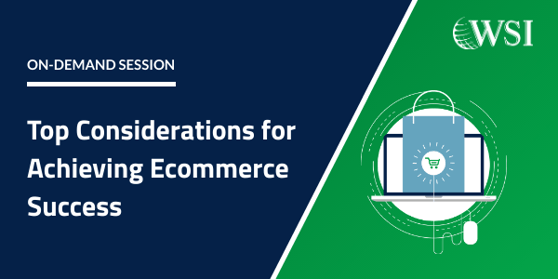Have you been wondering about how to start achieving eCommerce success? Then you are in the right place!
On the panel with your host and Director of Marketing and Communications at WSI, Cheryl Baldwin, Sharon Herrnstein, BA, MBA, and Chief Marketing Officer at WSI Digitaledge Marketing, and Heidi Schwende, Chief Digital Officer and Chief Marketing Officer at WSI Digital Moxie Inc., answered FAQ in an insightful conversation about adopting or improving eCommerce to help your business soars! ICYMI, you can watch the webinar here.
What’s the Big Deal About Ecommerce?
Ecommerce is everywhere! It does not matter if your focus is B2B or B2C; you can do eCommerce just about everything. The statistics on the growth of eCommerce speak for themselves:
- At the height of the pandemic, ten years of eCommerce growth happened in just three months.
- Over 2.14 billion people worldwide are expected to buy goods and services online this year.
- By 2027, global consumers are expected to spend up to $8 trillion (yes, with a “tr”) online.
- 81% of retail shoppers research online before making a purchase.
The Current Ecommerce Landscape
Ecommerce is evolving rapidly as consumer behavior and technological advancements reshape the industry. To achieve long-term success, businesses must adapt to these shifts and optimize their websites to leverage growth opportunities. Below are key success factors shaping the e-commerce landscape in 2024:
2024 Ecommerce Trends
- Mobile Commerce Domination: Mobile shopping continues to grow, with consumers favoring the convenience of buying directly from their phones.
- Rise of Social Commerce: Social platforms like Instagram, TikTok, and Pinterest are now essential sales channels.
- Demand for Personalization: Consumers expect tailored product recommendations, personalized email campaigns, and dynamic website content.
- Sustainability Matters: Buyers prefer eco-friendly brands, which influence purchasing decisions and brand loyalty.
Common Ecommerce Business Challenges
- Cart Abandonment: Complicated checkout processes and unexpected fees drive customers away.
- High Competition: Competing with major brands and smaller niche players requires effective branding and marketing strategies.
- Rising Customer Acquisition Costs: Ad costs are increasing, making retention-focused strategies essential.
What is The Best Way to Make Online Shopping a Great Customer Experience?
Wow! If the last year has taught us anything, it’s the value of adapting to online business. There is a caveat, though: success in ecommerce doesn't end at simply setting up a store. You must continuously refine and enhance the shopping experience for your customers.
Ecommerce must be done well to help you find new revenue streams and breathe life into your business. To get the online customer experience right, it needs to be simple and easy… on their side. That requires hard work behind the scenes, i.e., on the part of you and your purveyor. But trust our experts; the tough graft is so worth it!
Use customer data to tailor an online store that nurtures relationships with your client base to enhance growth. To gather data, draw from your email marketing, web analytics, Google analytics, and automation tools.
Provide users with an incentive to share, e.g., by creating an account rather than logging in as a guest each visit. Then, leverage their purchase history to segment customers to send perfectly personalized messages.
8 Proven Strategies to Achieve Ecommerce Success
1. Optimize Your Website for User Experience (UX)
A seamless, intuitive shopping experience is critical. Ensure your site is easy to navigate, visually appealing, and mobile-friendly.
Key Actions:
- Simplify navigation menus and categories.
- Use a mobile-responsive design to ensure smooth access across devices.
- Improve site speed, as slow load times increase bounce rates.
2. Leveraging Data-Driven Personalization
Personalized experiences increase engagement, sales, and customer loyalty.
Key Actions:
- Implement AI-powered product recommendations on category and product pages.
- Use email segmentation to deliver targeted content and exclusive offers.
- Leverage browsing and purchase history to create personalized shopping experiences.
3. Building Trust and Loyalty
Customers buy from brands they trust. Build credibility and create loyalty to drive repeat purchases.
Key Actions:
- Display reviews and testimonials prominently on product pages.
- Offer clear, hassle-free return policies to reduce buyer hesitation.
- Introduce loyalty programs or subscription models to boost customer retention.
4. Streamlining the Checkout Process
A fast, simple checkout process can dramatically reduce cart abandonment.
Key Actions:
- Use a one-page checkout to reduce friction.
- Offer multiple payment methods (credit cards, PayPal, digital wallets, etc.).
- Provide a guest checkout option for those who want to avoid creating an account.
5. Adopting Omnichannel Marketing
Your customers are everywhere, and so should your brand. Omnichannel marketing ensures seamless experiences across platforms.
Key Actions:
- Integrate your e-commerce site with social media shops (e.g., Instagram, TikTok, Pinterest).
- Run retargeting ads to re-engage shoppers who abandoned their carts.
- Use customer data to personalize messages on email, social media, and on-site popups.
6. Staying Ahead with SEO
Search Engine Optimization (SEO) ensures your store ranks high in search results, driving traffic and conversions.
Key Actions:
- Use long-tail keywords for product page optimization.
- Write high-quality, informative product descriptions and blog content.
- Update meta descriptions and titles to improve click-through rates (CTR).
- Create content-rich category pages that answer user questions.
7. Using Analytics to Make Informed Decisions
Data-driven decisions separate successful e-commerce stores from the rest. Analytics reveal trends, weak points, and growth opportunities.
Key Actions:
Track KPIs like conversion rate, customer lifetime value (CLV), and bounce rate.
Use tools like Google Analytics or Heatmaps to understand user behavior.
Conduct A/B testing on product pages, call-to-action buttons, and landing pages.
8. Adopting Sustainable Practices
Sustainability has become a deciding factor for modern consumers.
Key Actions:
- Partner with suppliers that prioritize sustainable production methods.
- Use eco-friendly materials for packaging.
- Highlight your commitment to sustainability on product pages and marketing materials.
Avoiding Common Pitfalls with Your Online Store
Even with a solid strategy, common pitfalls can slow growth. Here are strategies on how to avoid them:
- Overlooking Mobile Users: With mobile shopping on the rise, failure to optimize for mobile can result in lost sales. Ensure responsive design and mobile-friendly navigation.
- Neglecting Post-Purchase Communication: Stay in touch with customers after the sale with email follow-ups, review requests, and loyalty rewards to drive repeat purchases.
- Ignoring Product Images and Descriptions: Poor visuals and lackluster descriptions fail to inspire trust. Use high-quality product images and compelling copy to increase conversions.
FAQs about Ecommerce
Is Ecommerce Automation Worth It?
Ecommerce automation allows you to automate your online store similarly to the way you would your supply chain and so on.
There are third-party apps available, but many require complex workarounds that are too time and energy intensive. It is advisable to get help from your digital marketing agency because it’s important to find an automation solution that fulfills your needs.
How Important is Shipping Urgency?
Shipping urgency directly impacts the end-to-end user experience. Shoppers expect no more than two days of shipping, thanks to the Amazon effect. (But using Amazon as a platform for your online offerings is better suited to businesses already at scale rather than SMMEs.)
Your customer’s experience includes the delivery. Prompt and excellent order fulfilment increases loyalty while decreasing cart abandonment – often leading to positive online reviews.
How Important is Tracking Stock Limits?
The first prize is inventory levels that allow you to fulfill all your orders all the time. Realistically, though, consider what users will experience when something is out of stock – what will they see? Do you allow back orders? How will you contact them when restocked, etc?
Does an Ecommerce Store Need to Integrate with Existing Systems?
Properly integrated systems require careful and deliberate planning. Don’t rush. Rather, wait for guidance on the deliverable best suited to your technology stack.
What Business Data Needs to Be Imported?
Before you go any further, do a complete data backup!
An exacting task, complete business data migration imports a significant amount – from images to data about your customers, orders, products, and endless variants – to be accessed on your eCommerce site.
What Ecommerce Platform is Best?
Part of your online business strategy is knowing the differences between eCommerce platforms. Partner with your marketing technology specialist to find a hosting site appropriate for your budget, web development and support needs, and growth potential.
What Online Shopping Trends Are Predicted?
Online shopping trends may have accelerated and escalated because of COVID-19, but the trajectory was already in place. Even as we open up, the convenience of eCommerce will be appreciated and stay popular.
What is the Key to Winning Market Share Going Forward?
With droves of online shoppers, focus on pulling them in with offers exquisitely relevant to their habits (as gleaned from your tagged data). Win market share by knowing how to meet users in their moment of need.
What are the Next Steps for Success in Ecommerce?
Determine what the marketing spend will be to achieve your goals. Progress a step at a time, setting aside money for a strategic eCommerce marketing plan that delivers sufficient ROI and ROAS for growth. Only then should you consider investing in further technology to scale.
Seek out ways to improve your online shopping experience with an eCommerce strategy that will help your organization meet its goals. If you are ready to start achieving eCommerce success, get in touch with your local WSI Consultant without delay! You can also watch the full webinar recording here:







